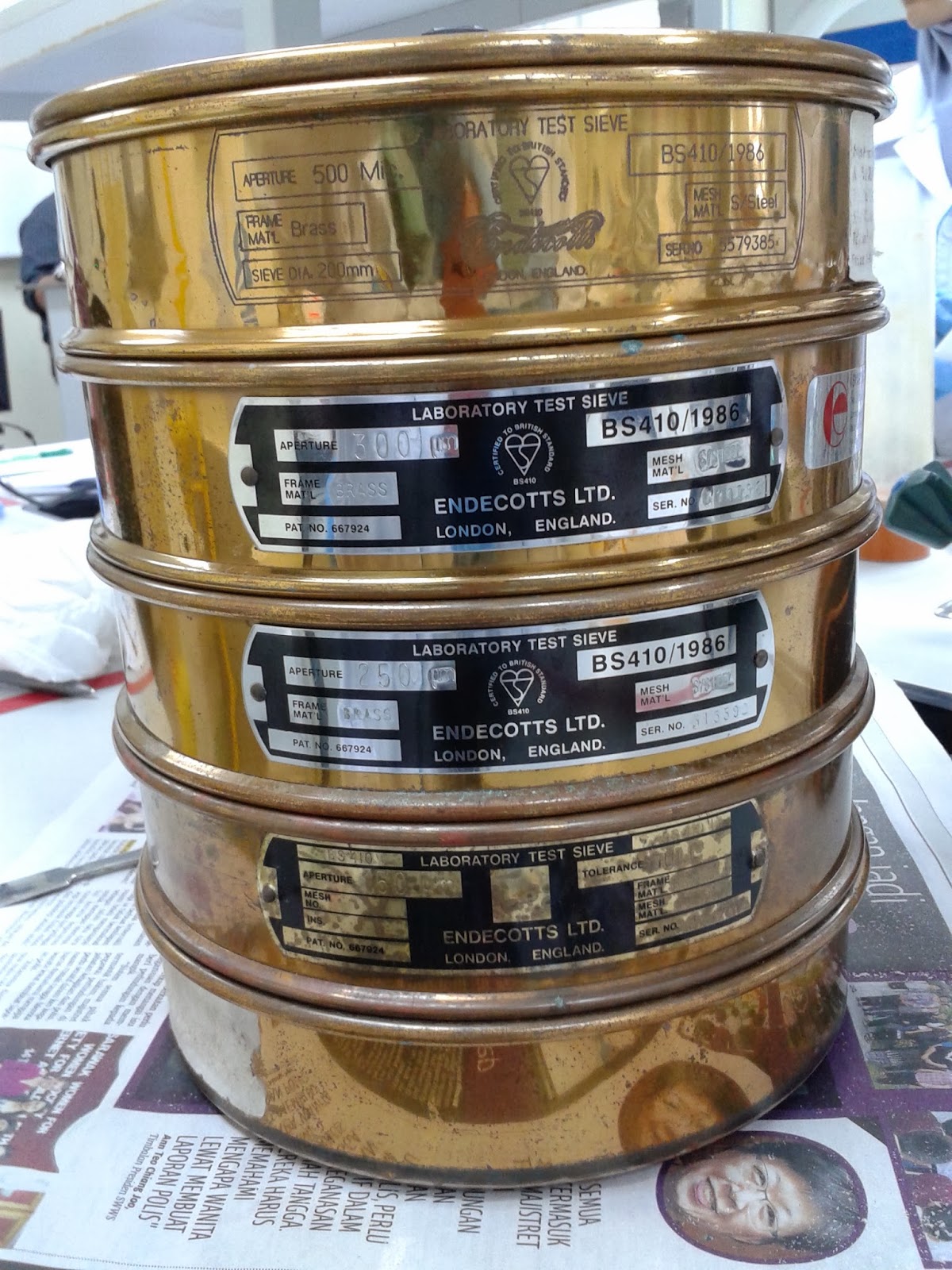Title: ball milling
Objectives: to find size distribution of
particles using sieving method
Apparatus: various sizes of ball milling, ball
miller machine, sieve
Materials: coarse salt
Introduction:
A ball mill, a
type of grinder, is a cylindrical device
used in grinding (or mixing) materials like ores, chemicals, ceramic raw materials and paints. Ball mills
rotate around a horizontal axis, partially filled with the material to be
ground plus the grinding medium. Different materials are used as media,
including ceramic balls, flint pebbles and stainless
steel balls. An internal cascading effect reduces the material to
a fine powder. Industrial ball mills can operate continuously fed at one end
and discharged at the other end. Large to medium-sized ball mills are
mechanically rotated on their axis, but small ones normally consist of a
cylindrical capped container that sits on two drive shafts (pulleys and belts are used to transmit rotary motion).
Methodology:
1.
300g-500g of coarse salt was
weighed.
2.
Ball milling with different
sizes were put in the mill.
3.
The weighed coarse salt was
then put in the mill too.
4.
The milling process was started
with 5rpm for 10 minutes.
5.
Then, the powder was sieved and
weighed for each sieving stage.
6.
Steps 1 to 5 were repeated with
different speed and duration.
7.
Histogram graph of particle
size distribution was plotted.
Questions
1. What are the factors that
influence the milling process?
Key properties
of grinding media are size, density, hardness, and composition.
Size: The
smaller the media particles, the smaller the particle size of the final
product. At the same time, the grinding media particles should be substantially
larger than the largest pieces of material to be ground. Density: The media
should be denser than the material being ground. It becomes a problem if the
grinding media floats on top of the material to be ground. Hardness: The
grinding media needs to be durable enough to grind the material, but where
possible should not be so tough that it also wears down the tumbler at a fast
pace. Composition: Various grinding applications have special requirements.
Some of these requirements are based on the fact that some of the grinding
media will be in the finished product. Others are based in how the media will
react with the material being ground.
2. What are the equipments that
can be used to reduce particles size?
Cutter mill, end-runner mill, roller mill,
mortar and pestle, vibration mill, hammer mill, pin mill and fluid energy mill
3. What are the factors that influence the choice
of the equipments?
Particles
properties and particles shape’s end product such as tough, sticky, abrasive
and friable. Product size required such as degree of size reduction and
economical.
Discussion
Theoretically when a substance undergoes
grinding process, particle size and mass of the substance will reduce. From
large particles become small particles until some of them become dust. This
dust then easily gone into the air causes lost of substance and reduction in
mass.
From the experiment, the initial mass of
coarse salt are more than the final mass, however for third trial, which is
using speed of 3rpm for 10minutes, the result is contradict. The initial mass
is 318.79g and the final mass is 330.25g. This is might be because of mistake
using the experiment. For example, either the initial reading or the final
reading is read or write mistakenly. Besides that, it is possible because of
the residue of the previous sieving process was not clean wholly, then the
residue was mixed with the current salt.
The second theory is the reduction of
particles size is not distribute evenly and the distribution is depends on the
speed and duration of the rotation. The size of the particles can be measured
by using sieving. If the speed is slow
and the duration is short, then the particles size is not reduce greatly. Thus,
the size of the particles will accumulate at large size compare to small size.
From the experiment, the particles size
reduction follows the theory where the particles sizes are accumulate at large
size. It is proven when the mass of particles at sieves with the biggest
diameters have the most masses for all trials while the smallest diameters have
the least amount of salt or no salt at all. From the data, comparing between
trials no 2 and no 3, trial no 3 has higher percentage of particles at 500mm
sieve compared to trial no 2. The percentage of trial no 3 is 97.6% while trial
no 2 is 89.7%. Besides that, trial no 3 has lowers percentage of particles at
0mm which is 0% compared to trial no2 which is 0.62%. Therefore, we can
conclude that the slower the speed and the shorter the duration of the
rotation, the particles distribution will be more at large size and will be
less at small size.
References
References
Aulton's Pharmaceutics The Design And Manufacture Of Medicines, Third Edition, 2007, Churchill Livingstone Elsevier, M. E. Aulton




No comments:
Post a Comment